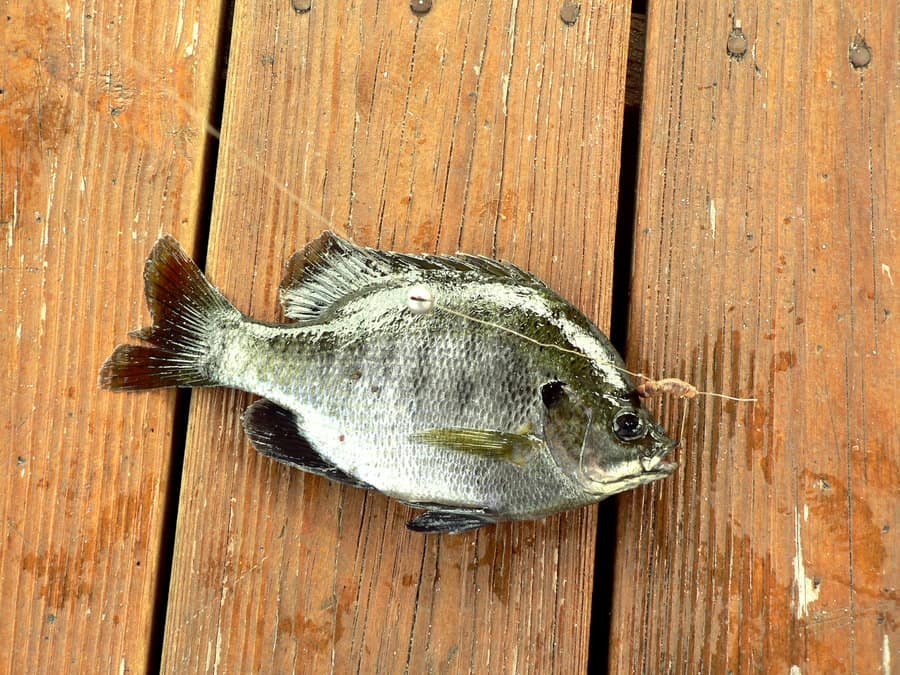Morning Bluegill Fishing (Complete Guide)
Leave a comment after this article and let’s talk more about bluegill fishing. I’d love to read your feedback.
Catching bluegill in the morning is highly effective due to their increased feeding activity in cooler, early daylight hours. For the best results, fish in shallow areas near structures like weeds or logs using live baits such as worms or small insects, or small artificial jigs.
| Factor | Description |
|---|---|
| Best Conditions | Cool, early daylight hours, preferably with calm water |
| Effectiveness | Highly effective due to increased feeding activity |
| Ideal Fishing Spots | Shallow areas near structures like weeds, logs, or docks |
| Recommended Baits | Live baits (worms, small insects), small artificial jigs or spinners |

Morning Bluegill Fishing
Check out this helpful guide on how water temperatures affect bluegill fishing year-round.
How to Catch Morning Bluegill
In the morning, particularly in the early hours just after dawn, bluegill are active and in search of food. This period of increased activity is primarily due to the cooler water temperatures and lower light levels, which make bluegill feel safer from predators and more willing to venture into shallower waters. It’s important to capitalize on this window of opportunity, as their activity tends to decrease as the sun rises higher and the water warms up.
Best Times for Morning Fishing
The prime time for morning bluegill fishing is from just before sunrise until a couple of hours after. During this period, you’re likely to find bluegill feeding aggressively. However, this can vary slightly depending on the season and weather conditions. Overcast mornings can extend the feeding activity a bit longer, while clear, sunny days might shorten it.
Where to Fish
Look for areas with abundant structures, such as weed beds, fallen trees, logs, rocks, or docks. Bluegill prefer these areas as they offer both food and protection. Shallow areas near the bank are particularly productive in the morning. In larger lakes, bluegill might be found around the edges of lily pads or other aquatic vegetation.
Click here for a complete breakdown of the best time of day for bluegill fishing. You may also be interested in an article we wrote on the best bait colors for bluegill.
Best Morning Bluegill Baits
Table: Best Baits for Morning Bluegill
| Bait Type | Best Spots for Each | Recommended Hook Type and Size |
|---|---|---|
| Live Worms | Shallow water near weed beds, under docks, or around submerged logs | Size 8-12, Aberdeen or circle hooks |
| Crickets | Areas with heavy vegetation or near the surface of the water | Size 10-14, light wire hooks |
| Small Jigs | Weedy or rocky areas, especially in slightly deeper water | Jig heads of 1/32 to 1/16 oz |
| Artificial Flies | Near the surface in open water or around the edges of vegetation | Size 12-16, dry fly or nymph hooks |
| Mini Spinners | Areas with slight currents or near the edges of structures | Spinner size 0 or 1 with built-in hooks |
Bobber and Live Bait: A simple yet effective technique is using a bobber with live bait. Worms, such as red wigglers or nightcrawlers, are excellent choices. Hook the worm through one end and adjust your bobber so the bait is just above the weeds or structure where bluegill are hiding. This method allows you to keep the bait at the right depth and provides a visual indicator when a fish bites.
Fly Fishing: For those who enjoy fly fishing, the morning is a great time to use this technique for bluegill. Small poppers or dry flies that mimic insects can be very effective. The key is to mimic the natural movement of bugs on the water surface.
Small Jigs: Another effective technique is using small jigs. Tiny jig heads with soft plastic bodies that mimic small insects or larvae work well. Cast near the structures and use a slow, steady retrieval method. The subtle movement of these jigs can entice bluegill to bite.
Spinners: Small spinners can also be effective in the morning. They create vibration and flash in the water, which can attract bluegill. Cast beyond the targeted area and retrieve the spinner slowly, allowing it to pass near the hiding spots of the bluegill.
Morning Bluegill Fishing Tips
- Use Light Tackle: Bluegill have small mouths, so use light line (2-6 lb test) and small hooks (sizes 6-12).
- Choose the Right Bait: Live baits like worms, crickets, and minnows are very effective. Small artificial jigs and soft plastics also work well.
- Fish Near Structures: Bluegill often stay close to structures like weeds, logs, or docks for protection and feeding.
- Pay Attention to Depth: In warmer months, fish in shallower waters; in colder months, go deeper.
- Use a Bobber for Live Bait: A bobber helps present the bait at the right depth and indicates when a fish bites.
- Try Fly Fishing: In the warmer months, bluegill can often be caught on the surface with small flies.
- Be Quiet and Stealthy: Bluegill are easily spooked, so approach fishing spots quietly and avoid heavy vibrations.
- Vary Your Retrieval Speed: Mix up the speed and pattern of your lure retrieval to find what attracts bites.
- Watch for Schools: Bluegill often school by size, so if you catch one, there are likely more nearby.
- Fish During Active Times: Early morning and late evening are typically the best times to catch bluegill.
- Use Small Spinners and Spoons: These can be effective, especially if the bluegill are aggressive.
Concluding Thoughts
Morning fishing for bluegill is most productive just before and after sunrise, especially in shallow areas near structures like weeds and logs. Effective baits include live worms, small insects, and artificial jigs or spinners, with techniques like bobber fishing, fly fishing, and jigging enhancing success by aligning with bluegill’s early-hour feeding habits.
